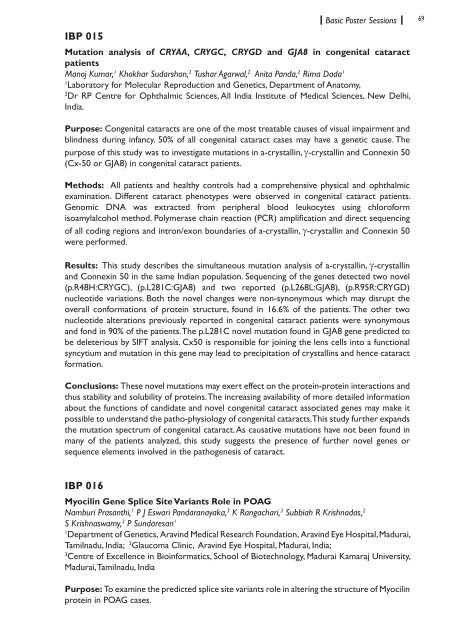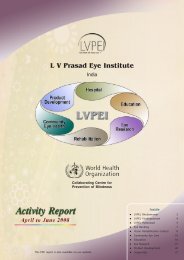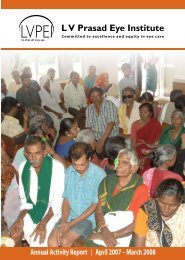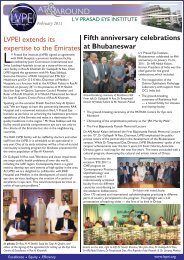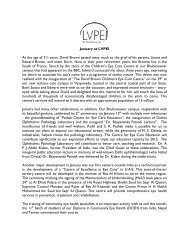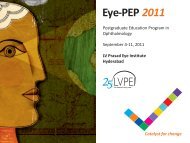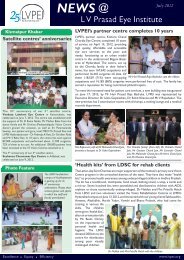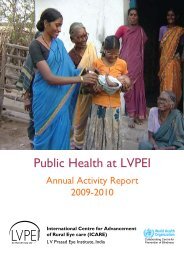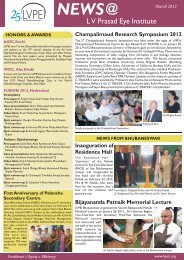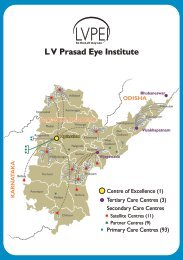IERG Abstracrt Book.indd - LV Prasad Eye Institute
IERG Abstracrt Book.indd - LV Prasad Eye Institute
IERG Abstracrt Book.indd - LV Prasad Eye Institute
You also want an ePaper? Increase the reach of your titles
YUMPU automatically turns print PDFs into web optimized ePapers that Google loves.
IBP 015Basic Poster Sessions69Mutation analysis of CRYAA, CRYGC, CRYGD and GJA8 in congenital cataractpatientsManoj Kumar, 1 Khokhar Sudarshan, 2 Tushar Agarwal, 2 Anita Panda, 2 Rima Dada 11Laboratory for Molecular Reproduction and Genetics, Department of Anatomy,2Dr RP Centre for Ophthalmic Sciences, All India <strong>Institute</strong> of Medical Sciences, New Delhi,India.Purpose: Congenital cataracts are one of the most treatable causes of visual impairment andblindness during infancy. 50% of all congenital cataract cases may have a genetic cause. Thepurpose of this study was to investigate mutations in a-crystallin, g-crystallin and Connexin 50(Cx-50 or GJA8) in congenital cataract patients.Methods: All patients and healthy controls had a comprehensive physical and ophthalmicexamination. Different cataract phenotypes were observed in congenital cataract patients.Genomic DNA was extracted from peripheral blood leukocytes using chloroformisoamylalcohol method. Polymerase chain reaction (PCR) amplification and direct sequencingof all coding regions and intron/exon boundaries of a-crystallin, g-crystallin and Connexin 50were performed.Results: This study describes the simultaneous mutation analysis of a-crystallin, g-crystallinand Connexin 50 in the same Indian population. Sequencing of the genes detected two novel(p.R48H:CRYGC), (p.L281C:GJA8) and two reported (p.L268L:GJA8), (p.R95R:CRYGD)nucleotide variations. Both the novel changes were non-synonymous which may disrupt theoverall conformations of protein structure, found in 16.6% of the patients. The other twonucleotide alterations previously reported in congenital cataract patients were synonymousand fond in 90% of the patients. The p.L281C novel mutation found in GJA8 gene predicted tobe deleterious by SIFT analysis. Cx50 is responsible for joining the lens cells into a functionalsyncytium and mutation in this gene may lead to precipitation of crystallins and hence cataractformation.Conclusions: These novel mutations may exert effect on the protein-protein interactions andthus stability and solubility of proteins. The increasing availability of more detailed informationabout the functions of candidate and novel congenital cataract associated genes may make itpossible to understand the patho-physiology of congenital cataracts. This study further expandsthe mutation spectrum of congenital cataract. As causative mutations have not been found inmany of the patients analyzed, this study suggests the presence of further novel genes orsequence elements involved in the pathogenesis of cataract.IBP 016Myocilin Gene Splice Site Variants Role in POAGNamburi Prasanthi, 1 P J Eswari Pandaranayaka, 3 K Rangachari, 3 Subbiah R Krishnadas, 2S Krishnaswamy, 3 P Sundaresan 11Department of Genetics, Aravind Medical Research Foundation, Aravind <strong>Eye</strong> Hospital, Madurai,Tamilnadu, India; 2 Glaucoma Clinic, Aravind <strong>Eye</strong> Hospital, Madurai, India;3Centre of Excellence in Bioinformatics, School of Biotechnology, Madurai Kamaraj University,Madurai, Tamilnadu, IndiaPurpose: To examine the predicted splice site variants role in altering the structure of Myocilinprotein in POAG cases.


